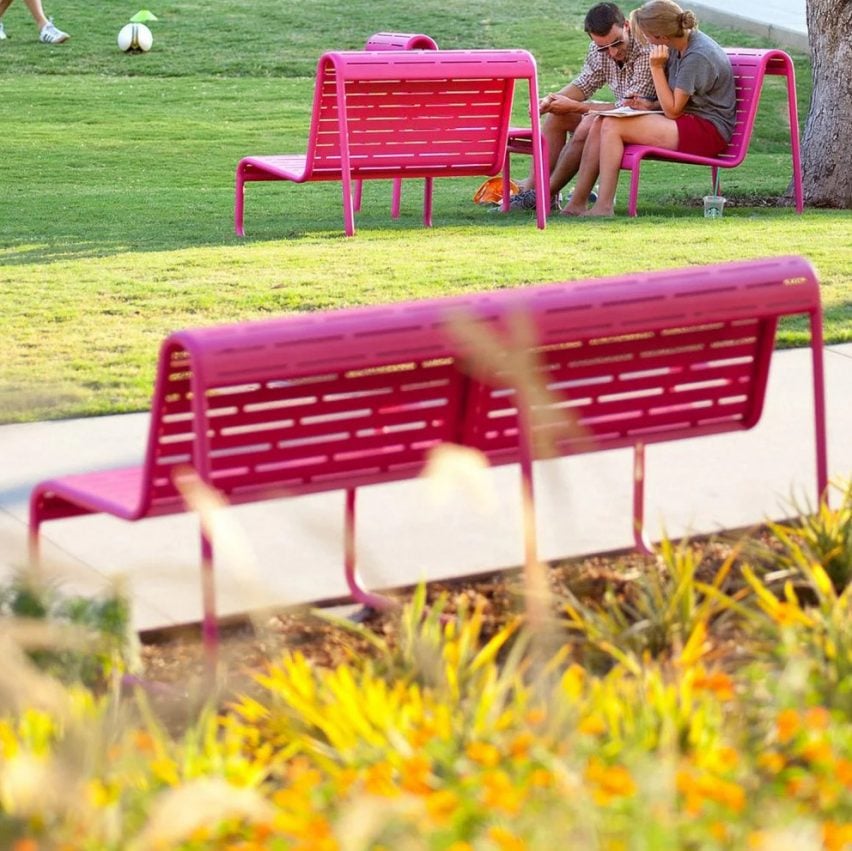Protesters have used the distinct pink furniture of a Los Angeles park as barricades during demonstrations in the city, sparking commentary from the bench’s designer Rios.
In a photo posted to Instagram, Rios shared a photo of protestors crouched behind the metal benches and chairs originally installed in Gloria Molina Grand Park (Grand Park) to shield themselves during the protests, which started last week in response to raids by federal immigration authorities in the city.
View this post on Instagram
Rios reshared an image showing the park benches being used as barricades in Los Angeles
Having originally designed the furniture for a park, Rios said that the use of the furniture represented a “fundamental” aspect of the original design.
“For us at Rios, the images shown of the Civic furniture series during the peaceful protests in LA capture hope, fear, resilience and the fundamental value of wonderful design – protection and comfort,” Rios partner Andy Lantz told Dezeen.
“Our ambition for our work at Grand Park and the pink furniture was to always allow freedom of movement, configuration and an overall participation that captured the value in community being defined by everyone that is inherently Angelino.”
“We embrace our communities across Los Angeles”
The bright pink furniture, including benches, chairs and tables, was designed by Rios for its Grand Park project completed in 2012.
At the time, the studio sought to create freestanding furniture that encouraged “freedom of movement, configuration and an overall participation that captured the value in community”.
“In the face of fear and uncertainty, we embrace our communities across Los Angeles and stand strong in providing protection to every walk of life that makes this city irrefutably resilient,” said Lantz.
According to the studio, the furniture played a large role in defining the park’s identity, which is located towards the northwest of the city next to Los Angeles City Hall and other public buildings.
The image has since resonated with others, including designer Eric Trine, who reposted the photo with the caption: “It really does make for a great barricade system”.
Upon installation 11 years ago, there were 26 freestanding benches, 41 wall-mounted benches, 120 cafe tables, and 240 cafe chairs. On Monday, a video by local outlet KCAL News showed city workers loading the furniture into a bulldozer.
Benches became “tools for resistance”
According to KCAL News, the furniture will most likely be discarded or repaired depending on the level of damage.
The act of repurposing design objects for protests has drawn attention from the design community in recent years. During the anti-war campus protests last year in the United States, Rhode Island studio Pneuhaus converted inflatable benches into self-defence devices.
Today, Pneuhaus told Dezeen that the use of the benches represents how objects can become “tools for resistance in the right context”.

“Having designed for protests in the past, we recognise so much of what happens in a protest is hard to predict,” Pneuhaus said. “In reality, people will ultimately use what they have access to. Sometimes the best protest tools are the ones already sitting on the street.”
“While design is ultimately a useful tool, resourcefulness and availability of everyday objects are what make them effective.”
Urban furniture has been part of ongoing discussions around the impact and power designers engage with while creating public spaces, both to benefit and control the public.
In Theo Deutinger’s Handbook of Tyranny, the architect and writer analyses how governments use public architecture and design to control populations, while author Edwin Heathcote explored the impact of street furniture in his book On the Street: In-Between Architecture.
The ongoing protests in Los Angeles over raids by immigration agencies have garnered national attention, with US president Donald Trump calling in federal forces to the city. Protests have since spread to other cities.
The photography is courtesy of Rios
The post Pink park furniture used as barricades in LA protests shows design's "fundamental value" says designer appeared first on Dezeen.

